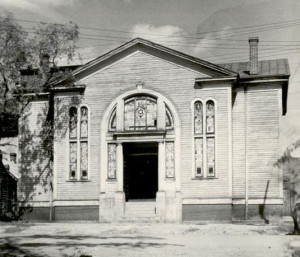History of Beth Shalom
Columbia, SC
 The Jewish community in Columbia has existed since the early 19th century. As in other early American cities, many of the town’s first Jewish settlers were Sephardic, with ancestors from Spain or Portugal. In 1846, Columbia’s first congregation was organized and given the name Sharit Israel—the same name that religious traditionalists in Charleston had adopted a few years prior, when they broke from Kahal Kadosh Beth Elohim in opposition to certain reforms.
The Jewish community in Columbia has existed since the early 19th century. As in other early American cities, many of the town’s first Jewish settlers were Sephardic, with ancestors from Spain or Portugal. In 1846, Columbia’s first congregation was organized and given the name Sharit Israel—the same name that religious traditionalists in Charleston had adopted a few years prior, when they broke from Kahal Kadosh Beth Elohim in opposition to certain reforms.
Columbia’s Sharit Israel met in a building on Assembly Street, upstairs from the Hebrew Benevolent Society, founded 20 years before. One of the nation’s earliest Jewish Sunday schools convened in the basement. In 1865, the structure burned to the ground, as General W. T. Sherman and his troops occupied the city.
Columbia’s Jewish community declined sharply after the Civil War, and then slowly grew with an influx of new immigrants from Eastern Europe. Henry Steele, who would become the first president of the Tree of Life, and Phillip Epstein, who would become the founding president of the House of Peace (later renamed Beth Shalom), were among the individuals who met together for services.
The group tried to compromise between Reform and Orthodox practices, but by 1905 the Orthodox families began conducting services in a separate space and, two years later, filed a lawsuit against the trustees of the Tree of Life. (See Epstein v Berman, 78 S.C. 827, 1907.) The Orthodox minyan met in a small house on Park and Lady Streets, and decided to call itself House of Peace. Congregants moved across Park Street into their first real shul, and in 1912 they received a state charter.
In 1915, Beth Shalom’s sanctuary burned to the ground—the city’s second synagogue lost to fire. The Torah scrolls were rescued by Isadore Gergel, who ran into the burning building to save them.
A larger structure was erected on the same site in the old style, with a bima in the center of the sanctuary. The second Park Street synagogue still stands today, moved from its original location to the corner of Park and Hampton. Known as the “The Big Apple,” named for a dance craze that was popular at the time, the building operated as a night club. The former Beth Shalom has been restored by the city of Columbia and is listed in the National Registry of Historical Buildings.
History taken from JHSSC Summer 2005 Newsletter